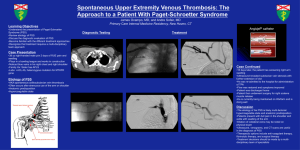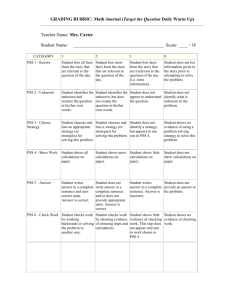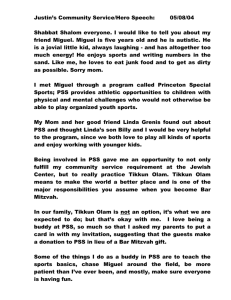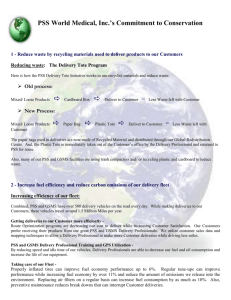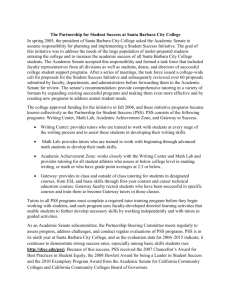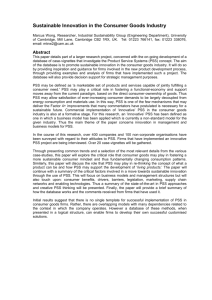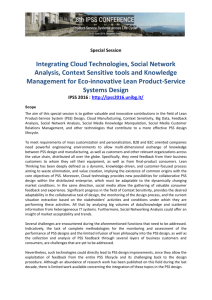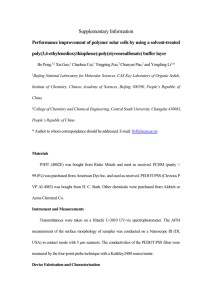Global Special Instructor Notes AchievGlobal
advertisement
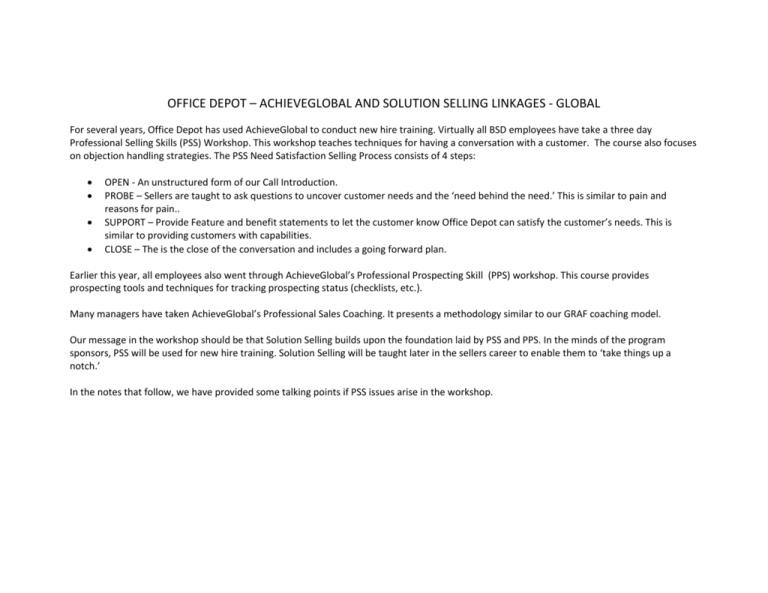
OFFICE DEPOT – ACHIEVEGLOBAL AND SOLUTION SELLING LINKAGES - GLOBAL For several years, Office Depot has used AchieveGlobal to conduct new hire training. Virtually all BSD employees have take a three day Professional Selling Skills (PSS) Workshop. This workshop teaches techniques for having a conversation with a customer. The course also focuses on objection handling strategies. The PSS Need Satisfaction Selling Process consists of 4 steps: OPEN - An unstructured form of our Call Introduction. PROBE – Sellers are taught to ask questions to uncover customer needs and the ‘need behind the need.’ This is similar to pain and reasons for pain.. SUPPORT – Provide Feature and benefit statements to let the customer know Office Depot can satisfy the customer’s needs. This is similar to providing customers with capabilities. CLOSE – The is the close of the conversation and includes a going forward plan. Earlier this year, all employees also went through AchieveGlobal’s Professional Prospecting Skill (PPS) workshop. This course provides prospecting tools and techniques for tracking prospecting status (checklists, etc.). Many managers have taken AchieveGlobal’s Professional Sales Coaching. It presents a methodology similar to our GRAF coaching model. Our message in the workshop should be that Solution Selling builds upon the foundation laid by PSS and PPS. In the minds of the program sponsors, PSS will be used for new hire training. Solution Selling will be taught later in the sellers career to enable them to ‘take things up a notch.’ In the notes that follow, we have provided some talking points if PSS issues arise in the workshop. Slide Visual Notes SPI’s Solution Selling® continues to build on the Needs Satisfaction Selling™ philosophy taught in Professional Selling Skills® (PSS) and Professional Prospecting Skills™ (PPS). In PSS, you learned how to manage sales conversations in a consultative, mutual fashion. This was accomplished via the methodology of Open/Probe/Support/Close. p.4- AchieveGlobal within the Sales Process In PPS, you learned how to utilize the Prepare/Contact/Assess process to gain appointments with prospects in a systematic fashion Now, we are focused on what happens as you string all these conversations together over the course of an end-to-end sales cycle from Engagement through to Proposals and ultimately Fulfillment. The Solution Selling™ program will outline what this sales process looks like on a phase by phase basis and will provide you with specific skills, tools and techniques you will need to move your opportunities successfully through the sales p.11- Quid Pro Quo p. 13- No Pain, No Change p. 16- 4 levels of buyer need Quid pro quo links to the idea of mutual and mutuality discussed in PSS Pain” links to the idea of customer business issues as taught in PPS and needs behind the need in PSS PSS Notes: Level Four: Active Evaluation : this equates to the confirm existence of a need Level Three: Vision of a Solution : this equates to Examine Effects Level Two: Admitted Pain: Identify Opportunities Level One: Latent Pain: AchieveGlobal calls this phase exploring customer’s circumstances p. 40- Anchor slide- create interest Strong connection here between SPI and the work they do in PPS in the contact phase. NOTE: some sellers (mainly TDM) may fill out a PSS ‘Call Planner’. This is a document that helps them plan to a sales call. If they currently fill this out, they will continue to do so in the future P. 42 - business development best practices Inserted funnel and 3rd best practice: Analyze funnel to plan activity and determine level of activity needed. You should have some understanding of the amount of leads you must put into the funnel to get the desired revenue out on the back end. p. 47- reference story p. 59- anchor slide get pain admitted In PSS reference stories are called “Proof Sources.” In PSS this is called “confirming the existence of a need.” p. 63- call introduction p. 66- situational questions This all happens during the Open step of PSS. The Call Introduction provides a little more structure for the open phase State call agenda (instead of objective- conflicting with PSS language) Use “we help” theme (instead of positioning statement- conflicting with PSS language) PSS Notes: Situation questions in PSS are Circumstances Menu of Pain in PSS are opportunities p. 67- anxiety p. 165 - Pipeline analysis Anxiety Creation in PSS is Examining Effects and Confirming the existence of the need PPS teaches how to track call/hit ration to determine how many prospects they need to contact to meet gap
